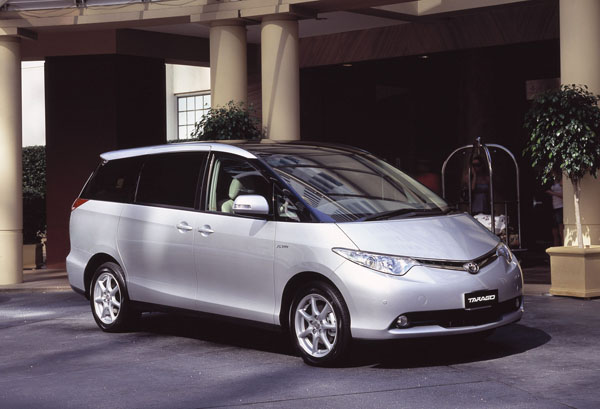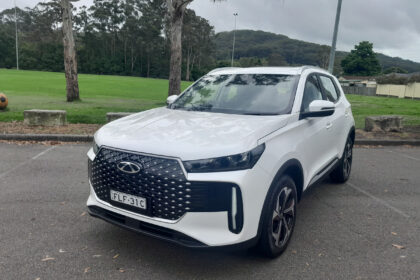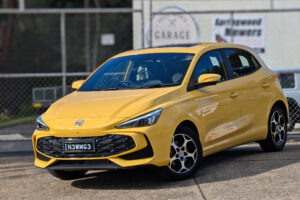Toyota Tarago has been sold in Australia in large numbers since the 1980s. Early versions were nothing more than delivery vans with extra seats, side windows and a bit of added trim. From 1990, Tarago was a pure people mover with all that means in the way of comfort and safety. These are the models being surveyed here.
The Tarago is spacious, with a virtually flat floor throughout. Moving about inside isn’t all that easy due to the relatively low roof however, Tarago is hardly alone in this.
Seating is provided for seven or eight, depending on whether the centre row has twin individual seats or a three-place bench.
A real weak point of the 1990 to 1999 Tarago is that all rear occupants have to get in and out of a single side door. The all-new model of 2000 had passenger doors on both sides, as has every model since.
Boot space is reasonable even with all the seats being used – and very large if the rear seat is folded out of the way. It’s not possible to carry large amounts of luggage for seven or eight people if they are all travelling in the vehicle, but again this the norm in most people movers.
Comfort is generally good, though rough roads with a fair load on board may cause the ride to deteriorate. Handling is good – for a people mover, that is – and it’s safe in the way the vehicle understeers to push itself back into line if the driver makes a mistake.
Tarago has good resale value so you will pay top dollar for a good one. Hopefully, the extra price when you buy is is still there with it become time to trade it in.
Performance from the four-cylinder, 2.4-litre engine is adequate for most drivers, though the Tarago will struggle on hills if it’s carrying a big load.
Toyota offers the option of a five-speed manual gearbox or a four-speed automatic transmission on the four-cylinder versions, with the auto being by far the more popular. Manual gearboxes could be hard to get out of when it comes time to trade or resell. The 2012 model year saw the introduction of a far more efficient CVT automatic transmission.
A 3.5-litre V6 engine option for the Tarago was introduced in 2007, it wasn’t all that popular at the time as it was relatively expensive, but sales have improved in recent years. The V6 engine comes with a six-speed automatic as the engine’s torque, when compared to the four-cylinder, means it doesn’t need a CVT. Having said that, one may be in the pipeline.
Most Taragos have rear-wheel drive, but some early models offered the option of extra grip by way of four-wheel drive. These latter weren’t aimed at off-road users, but at providing greater safety on icy and/or unmade roads. As they are heavier they lose some performance and have higher fuel consumption.
Toyota’s spare parts network is one of the largest in Australia and has operated efficiently for decades. Parts prices are about average for this type of vehicle. Some body parts on the 1990 to 2000 Tarago can be pretty expensive due to their size and complexity.
We haven’t heard any complaints about availability of parts on early models, but they are getting on in years so problems may surface soon. Recyclers are a handy source of parts for older cars.
Toyota Taragos have been a longtime favourite with commercial operators, as hotel shuttle buses and airport transfer vehicles. These may have done some hard work, though to compensate for this they are usually serviced by the book. Ask to see the service records.
Insurance on the Tarago can be slightly more expensive than average but not outrageously so. Shop around for the best deal, but be sure to understand exactly what you are getting for your money.
WHAT TO LOOK FOR
Check the condition of the seats, carpet and trim carefully for signs of heavy-duty usage, particularly in the back if you suspect you’re looking at a onetime shuttle bus.
Make sure the engine starts easily. Ideally get to it when it’s stone cold in the morning, and look for a puff of smoke from the exhaust when it first kicks over.
Engine wear may also show up smoke from the exhaust pipe when the engine is accelerated hard after it’s been idling for a while.
The gearbox or automatic transmission should be precise and smooth in operation, with no crunching from a manual gearbox on fast downchanges.
We have come across more than one Tarago 4WD that has obviously spent time at the beach. Beware…
Look for rust in the lower areas of the body and in the floor of the cabin and luggage area, though it’s certainly not a common occurrence. Vehicles badly repaired after a crash may suffer from rust.
CAR BUYING TIP
People movers can suffer from the ravages of bored little darlings in the back, so make sure you do a serious check of the areas back there.














